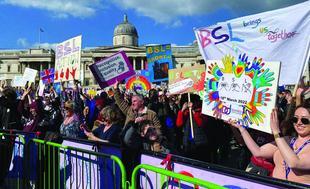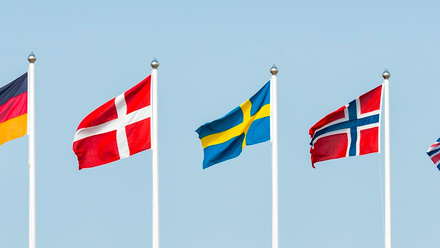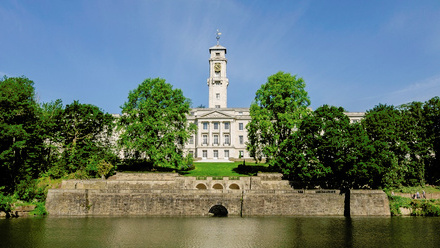Signed and delivered
British Sign Language has finally been recognised in law as a language of Great Britain. Lauren Harris explores what this means for BSL interpreters and translators
It has been rather an eventful year for the Deaf community, which – to be frank – doesn’t usually attract a great deal of media attention.
You may remember Eastenders actress Rose Ayling-Ellis, who is Deaf, winning the Strictly Come Dancing 2021 glitterball trophy last December. She impressed the judges – and the nation – with a moving performance in which she danced beautifully with her partner Giovanni Pernice, including in a section performed in complete silence. Then at the Oscars in March, Troy Kotsur became the first Deaf actor ever to win an Academy Award for his role in CODA, a film about a girl growing up as the only hearing person in a Deaf family. CODA also won Best Picture, bringing stories about families who sign to the attention of Hollywood and the wider world.
British Sign Language explained
BSL is a language in its own right. It is a natural, visual-gestural language distinct from spoken English, with its own vocabulary and grammar, and one of Great Britain’s indigenous languages, along with English, Welsh, Scots, Scottish Gaelic and Cornish. Sign language is not universal: other countries around the world have their own forms of sign language.
Deafblind people communicate with a range of forms of BSL, including tactile signing (in which the Deafblind person touches the hands of the signer to read the signs, or the signer spells words onto the Deafblind person’s palm) and ‘visual frame’ signing (in which the signer adapts their signing space to accommodate the Deafblind person’s field of vision). Overall, the British Deaf Association estimates that there are around 151,000 people who use BSL in the UK, 87,000 of whom are Deaf or Deafblind.
Qualified hearing professionals who interpret between spoken English and BSL (in both directions) are known as registered sign language interpreters (RSLIs). Some, but not all, are heritage signers: that is to say, native signers with Deaf family members whose first language is BSL. Registered sign language translators (RSLTs) are Deaf professionals who are native BSL signers and who interpret between written English (eg documents or an autocue) and BSL. A third emerging profession is that of Deaf relay or Deaf intralingual interpreters, which refers to Deaf professionals who broker communication between a hearing BSL interpreter and Deaf clients, who may have specific or complex language needs. Deafblind people are supported by the small number of BSL interpreters who have been trained in the specific forms of BSL used by Deafblind people.
However, during the pandemic, many BSL interpreters had no choice but to move to remote interpreting, setting themselves up at home with green screens, ring lights and (where possible) faster broadband to allow for seamless video calls. This practice looks set to stay, despite recent concerns – for example about police interviews increasingly relying on video interpreters, which can put the Deaf person at a disadvantage (and would be impossible for many Deafblind people).
More positively, a new 999 BSL video relay service (VRS) launched in June this year, enabling Deaf people to call the emergency services (police, ambulance, fire and coastguard) via a remote BSL interpreter for the first time, rather than relying on the existing slow text relay service, or asking a hearing person (who may not know how to sign) to call on their behalf.
Access to interpreting services
In practice, however, many people have not had access to these professionals. Rather, it has become the norm for Deaf people to expect little or no equal access to public information and services in their own language. Until now, they have had no legal right to demand an interpreter.
The BSL Bill (now Act) was presented to Parliament by Labour MP Rosie Cooper, herself a child of Deaf adults (CODA) whose home language was BSL. During debates on the Bill, Cooper described the ‘unbelievable pressure’ she felt having to interpret for her Deaf parents from a young age, for example at medical appointments investigating her mother’s suspected breast cancer when she was just 15.
As shocking as it may sound, this is far from an isolated incident. The Equality Act 2010 only goes so far as to guarantee Deaf and disabled people ‘reasonable adjustments’. So GPs and hospitals have long expected Deaf patients to put up with scribbled notes in English or asked them to bring along a family member – sometimes a child – to attempt to interpret complex, potentially life-saving medical information. One hearing woman with a Deafblind partner was told she’d have to interpret for him herself while she was giving birth to their son. According to the hospital’s policy, he had no right to request communication support, as he was not the patient. (Full disclosure: that woman was me.)
During the Covid pandemic, thousands of Deaf people had no way to contact their GP, as many practices had switched to telephone consultations and did not provide email addresses or offer BSL-interpreted video appointments. BSL users were forced to rely on the charitable support provided by organisations such as SignHealth, which launched a free on-demand 24/7 remote interpreting service called BSL Health Access, in partnership with InterpreterNow. That service has now closed because of lack of funds.
Number 10 finally relented after the #WhereIsTheInterpreter campaign took the government to court and the media got hold of the story.
Similarly, Deaf children have no right to qualified interpreters through their education, instead being either mainstreamed and expected to lipread their teachers all day (an exhausting experience – just give it a try) or being provided with ‘communication support workers’ with various levels of BSL fluency and interpreting skill (some with just BSL Level 1 – the equivalent of a GCSE).
In fact, the only place where BSL is currently required by law is in police settings and in court thanks to the European Convention on Human Rights. Even there, things have not always gone smoothly – cases have been dropped because only one qualified sign language interpreter, or no interpreter at all, was available. Like conference interpreters, RSLIs prefer to work in co-working pairs and switch every 20 to 30 minutes.
Signs of progress – but what about rights?
The Deaf community is celebrating this historic moment, which represents a positive step forward in empowering BSL signers to access vital public information and services such as healthcare and education in their first or preferred language.
The Act also requires the Secretary of State for Work and Pensions to report on the promotion and facilitation of the use of BSL by ministerial government departments, and requires guidance to be issued in relation to BSL. Government departments will now have to produce annual reports on what they have done to promote and facilitate the use of BSL in their public communications, such as press conferences, policy announcements, consultation documents and websites. The Secretary of State will be required to issue guidance on best practice for communicating with BSL users, and share case studies with government departments to illustrate the value of providing BSL interpretation in communications with the public.
A non-statutory advisory board of BSL signers from England, Scotland and Wales is due to be formed this summer, with the mandate of conveying the perspectives and priorities of those with lived experience of deafness. (It is not yet clear whether BSL interpreters will be invited to join this.)
This will be absolutely crucial to its success. At the moment, for the estimated 87,000 Deaf BSL users in the UK, there are just 1,710 communication professionals (interpreters, translators, lipspeakers, speech-to-text reporters and note takers) currently on the books of the regulatory body, the National Registers of Communication Professionals Working with Deaf and Deafblind People (NRCPD). That’s 50 Deaf people for every one communication professional – and that’s without taking into account the many areas in the UK where there is no interpreter to be found for miles around.
The BSL Act will certainly bring with it greater demand for BSL content and plenty of opportunities for interpreters and translators. But, in reality, will it persuade more people to start learning BSL from scratch and to work their way up to becoming qualified interpreters?
BSL is currently not taught in school, although a BSL GCSE is in development. Evening classes are available but not cheap, even for the hearing families of Deaf children, who desperately need them in order to communicate as a family. For those who do learn, or have grown up using BSL, there are several routes to qualification as a BSL interpreter or translator, both academic and vocational. Courses vary in cost but they almost always involve a considerable financial investment before interpreters are able to start taking on paid work. It takes an average of seven years from learning BSL to becoming a qualified interpreter.

After decades of passionate campaigning by the Deaf community, the UK Parliament has marked a major milestone by finally recognising BSL
Once qualified, BSL interpreters and translators often go freelance, although some sought-after in-house positions, for example at schools, further education colleges and councils, do exist. Freelancers work with a combination of direct clients, some funded by the government’s Access To Work budget (which has been criticised for long delays in processing interpreters’ invoices), and via agencies, which exert a constant downward pressure on fees to maximise profit margins. The National Union of British Sign Language Interpreters (NUBSLI) issues national and regional fee guidance, but rates vary wildly depending on the assignment, the client, the available budget and the interpreter’s own experience and knowledge of the subject matter. A NUBSLI-led boycott of LanguageLine Solutions in Sheffield in 2016 over squeezed rates resulted in the agency eventually backing down.
So, while the government has stated its intention to ‘examine how to increase the number of BSL interpreters’ in the UK, it has yet to announce how it will achieve that goal in practice. Some of these incentives might include subsidised BSL classes (free for families of Deaf children); a BSL GCSE and A level to prepare students for degrees in BSL Interpreting or Deaf Studies (which already exist, but often need to teach students BSL from scratch); bursaries for student interpreters to support them as they work towards qualification; paid internships for trainee interpreters where they can shadow and learn from more experienced peers; and sustainable rates for BSL interpreters working with the public sector.
When the Act was passed, David Buxton, the chair of the British Deaf Association, who led the ‘BSL Act Now’ campaign, said: ‘While today is a day to celebrate, we are aware that this marks the first step on the long path towards providing truly equal access to public services, information and opportunities for Deaf BSL signers in Great Britain. We hope that the legal recognition of BSL will encourage many more people to learn British Sign Language and go on to become interpreters, bilingual professionals and allies of the Deaf community.’
Now we all need to wait and see whether those hopes do in fact become reality, or whether the government is simply paying lip service to respecting the equal rights of the Deaf community.
Never miss another Bulletin article

If you would like to read more features and articles on a wide variety of subjects relating to all aspects of the translation and interpreting industry, subscribe to ITI Bulletin. Alternatively, join ITI and get a free subscription included in your membership.






